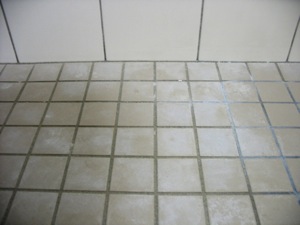

日本語
Bathrooms--I like to use just a couple of minutes to use a white sponge (called Erasers in America) to clean a 2x2 area each time I get in the shower, so it doesn’t get to be such a huge job. White sponges also polish up the chrome really well, and take out any ring or scum in the bath tub. White sponges do not work on rough floor tiles or grout--they disintegrate before they can clean.
I have tried many products and strategies to clean the white mineral deposits and scum on our rough shower floor--all unsuccessful. But I have finally discovered a strategy that works. Sprinkle a thick layer of baking soda on the shower floor, drizzle with dish detergent, and vinegar. Let it sit a few minutes while the vinegar causes the baking soda to foam, and the baking soda keeps it in place. Then use a scrub brush to scrub away the stains. Repeat for stubborn stains. You have to use all 3 products together--any combination of 2 does not work-believe me, I have tired!
But let’s face it. Sometimes things get crazy, and the mold gets out of hand before you clean it. This is when you need Mold Killer. Just spray it on, wait 10 minutes and then rinse clean. Although it is a spray, it comes out as a foam so you don’t have to worry about breathing the droplets, but you still need to worry about breathing the fumes, so open a window and turn on a fan. I do not use it on the ceiling because it might drip into my eyes or skin. For the ceiling, I use a solution of water and grapefruit seed extract, and climb on a ladder to wipe it down by hand. Mold can be dangerous to your health, so try not to let it stay very long.
Kitchen fan--If the filter is not disposable, place filter in the sink, or flat in a plastic tub. Put paper towels on both sides, and pour vinegar over it. If you can fill the sink or tub with enough vinegar and water to cover the filter, that is better--you do not need the paper towels in that case. Let is sit for about 10 minutes, discard the paper towels, drizzle dish detergent over the filter, and scrub both sides with a scrub brush. Rinse, let dry and replace. The fan blades clean fairly easily with white sponges and water.
Walls, ceilings and floors--living in Tokyo for more than a couple of years, you discover that everything turns gray--the walls, ceilings, curtains, and even insides of cupboards. So once a year, or every couple of years. I use microfiber cloths and water to clean them. It is especially convenient if you have a mop that takes cloths because you can clean the whole wall without having to use a chair or ladder to reach the high areas. If you try to do the whole house or church all at once, it can seem overwhelming. So just pick one wall, and it will be done in 5 or 10 minutes. Just take things out of one cupboard, and it is only a 30 minute job. Keep looking for small bits of time to clean small areas until the whole house or church has been cleaned. If you live in an old house or church, more than likely the walls are already gray. Try using a white sponge on a small area to see if it cleans--you might be surprised at the real color of the wall! But be warned: if you try it on a big wall, and it comes clean, you need to clean the whole thing, or it will look bad. So if you test a big wall, make sure you have the time to clean the whole thing before you test it! If you use white sponges, be sure to use a wet cloth to rinse,often, and keep rinsing the cloth frequently--otherwise you are only smearing the dirt around. I used white sponges to clean the linoleum floor in the church bathroom, and was shocked to discover that the floor was pink! Places where people touch get dirty even more quickly, so these areas should be cleaned every few months, and at least once a year--places like the walls around light switches, doors, stairwells, and the walls near where shoes are taken on and off.
Windows and screens --A long handled squeegee and 2 buckets, and a rag are the quickest way to clean windows. Use one bucket to rinse the dirty squeegee, and the other bucket to wash with clean water. For inside, a short squeegee may be more convenient. Wash the window with the sponge side, and rinse the squeegee. Squeegee around the edges of the windows and rinse the squeegee. After that, do not touch the edges of the windows, and make sure each stroke overlaps the previous stroke. Wipe the squeegee blade dry after each stroke. If there are sticky or greasy spots on the window, Window cleaner and paper towels should be used (or a white sponge.)
Screens get quite dirty, and if you leave windows open, the curtains are going to blow against them and get dirty. First, you can vacuum them if you tape a single layer of newspaper to the back side, or get someone to hold one sheet and move it as you finish vacuuming that spot. If you try to vacuum it without the paper, the air gets sucked through the holes in the screen, and no dirt is sucked away. Then take down the screens, hose down and wipe with a rag.
Dusting and vacuuming--Vacuum before dusting, as that kicks up more dust. When you vac, be sure to vac the sofa and occasionally the curtains to cut down on the dust accumulation, and to keep them from turning gray. Use an attachment for thin curtains if they get sucked up into the vac.
For dusting, I like to use the disposable Wave duster. If I keep it handy, it is simple to quickly dust things as I walk through the room. I have one upstairs and another downstairs so I am more likely to use it. I like to begin high, and on light colored items first. Then work my way down to lower items and dirtier items. So I begin with white doors and picture frames, then large horizontal surfaces, books on shelves, then end with the baseboards and the back side of the heater. If I have not dusted the light for a long time, I do that last, even though it is high, because it can get very dirty because it is too high to see well. If it’s not too dusty, I can dust the whole house before throwing it away. If you don’t have access to these dusters, a damp cloth with work. Do not use a feather duster, as that only flicks the dust in the air to breath, and resettle where you just cleaned.
Air conditioner-(Japanese wall units, only)-One year I was shocked find mold growing all between the fins of the air conditioner, and was horrified to realize that the air conditioner was spewing mold in the air for us to breath. I hired a pro to come clean the unit, and was even more shocked to see how black the water turned. Then I thought the problem was solved, but the next year, the water turned just as black. But I realized that I could do what they did, and save a ton of money. So here’s how to do it.
First, take out the filters and vac them every two weeks. Put them against the floor so that the suction pulls the dust loose. If it is very dirty, scrub it with water and a scrub brush. The reason you need to do this is that if the dust accumulates, it will end up clogging the hose that allows water to drip outside, and the water starts dripping inside onto your carpet or tatami. Every time you are about to turn off the air conditioner, turn it on the dry setting 30 minutes before you turn it off to dry it out and discourage mold growth.
Before you start using the air conditioner for the summer season, buy air conditioner cleaning spray (2 cans are about 500 yen at home centers), and a special plastic bag to put over the air conditioner to catch drips. If you can’t find bags made for that, any large plastic bag will do--just find a ladder or table that lifts a bucket to the level of the bottom of the bag to catch the drips. First, unplug the air conditioner. Open the front cover of the air conditioner, or take it off, depending on the style. take out the filters and clean. Tape the plastic bag to the air conditioner unit, and place the bucket below to catch the drips. Spray the fins of the air conditioner with the spray until the can is all used up. (Follow the instructions on the can.) I do not like the thought of breathing those chemicals, so I use the garden hose to gently hose it down, after leaving the chemicals to work for 20 min., or what ever the instructions say. The professionals have a compressor that allows them to spray water into the unit, but I don’t have one of those. If you do not have a garden hose that will reach, you can use a spray bottle, but it will not be as effective. Be very careful if you are using the garden hose--to not get the motor of the air conditioner wet, or set the spray too hard so it bends the fins. Let the air conditioner dry for 24 hours or a couple of days before running.
I also do one more step that the professionals do not do. When I was cleaning the air conditioner for the first time, I was again horrified when I tried to grip the barrel that causes the air to blow out of the unit, and my fingernails filled with black--mold? Pollution? I don’t know, but what ever it was, I knew I did not want to breath it. I tried to use q-tips, but they were too short, and I was using hundreds. So, I invented a tool. I cut a thin 100 yen cutting board into a strip wide enough to fit in the slots of the barrel. Then I glued 4 layers of disposable dish cloth to one end, cut just a bit wider than the plastic strip. Then I cleaned each hole, rinsing the tool in dirty water, then dipping in clean water to clean the next hole. I did put grapefruit seed extract in the water to kill any mold that might be growing there. This is quite time consuming, but gives peace of mind for what my family is breathing.
Spot removal





